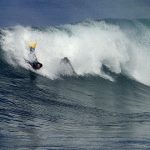There is a debate among surfers and bodyboarders about which is the better wave riding activity. This debate is evident on many beaches around the world. Unfortunately, bodyboarders often face unsolicited hatred from other aquatic sports.
Why is surfing the superior sport? Most surfers will argue that it is more challenging to learn and master.
While this may be true, it does not take away from the fact that bodyboarding also requires a lot of skill for some of its more complex stunts.
In the end, it is up to you to decide which of these two extreme water sports is best for you.
Is Bodyboarding the Same as Surfing?
The main difference between surfing and bodyboarding is that in surfing, the rider stands on a surfboard, while in bodyboarding, the rider lies on their stomach on the board. Both sports involve riding waves, but the similarity pretty much ends there.
For example, surfing requires more balance and coordination than bodyboarding, and is considered more difficult to learn. Additionally, the waves that are suitable for surfing are different than the waves that are ideal for bodyboarding.
Surfing waves are typically longer and more powerful, while bodyboarding waves are typically shorter and weaker. Bodyboarding is also typically done in waves with a hollow section, which is necessary for performing tricks.
The goal for bodyboarding is to ride a wave continuously, just like in surfing. Both sports use a board to catch and ride a wave back to shore.
Balancing and turning skills are also important for riding a wave successfully. Riding a bodyboard or a surfboard is always exciting and adrenaline-filled.
Does Bodyboarding Help Surfing?
Time spent bodyboarding will help transition into surfing. Bodyboarding gives a better understanding of the ocean’s waves and the right timing to ride it. Navigating around the ocean frequently will help familiarize with the surf zone, boosting confidence in the water.
Bodyboarding can improve your physical fitness, arm and core strength, and cardiovascular fitness. It can also help you paddle more powerfully and efficiently.
What Is the Difference Between Bodyboarding and Surfing?
Shorter boards. A bodyboard is shorter than a surfboard, which makes it easier to maneuver in the water. Less reliant on waves. You can bodyboard in smaller waves than you can surf, making it a great option for days when the waves are smaller.
More versatile. You can surf on different types of waves, but bodyboarding is more versatile because you can also ride in whitewater and on shorebreaks. There is a long-standing debate between surfing and bodyboarding enthusiasts about which is the better sport.
Bodyboarding is often seen as the easier of the two, as the shorter boards are easier to maneuver in the water and they don’t require as large of waves to ride. Bodyboarding is also more versatile, as it can be done in different types of waves and water conditions.
In the end, it comes down to personal preference as to which sport is better.
- Board in use: Surfboards and bodyboards have almost the same durability, but most bodyboards are stiffer than a surfboard. Surfboards are usually longer and heavier, while boogie boards are shorter and lighter. Because of the bodyboard’s smaller size, it is easier to transport than a surfboard.
- Ease of Learning: It is very evident that bodyboarding is easier to learn than surfing. This is because a beginner will have more control when lying on the board compared to surfing which requires the surfer to stand up when riding a wave.
- Execution: Bodyboarding and surfing both aims to catch and ride a wave. One of the most distinct differences between these two sports is that surfing rides a wave while standing up while bodyboarding is done while lying down on the bodyboard.
- Safety: Since bodyboarding is mostly performed with the body lying on the board, a bodyboarder will less likely to get injured from falling in the water.
- Price: If you are eyeing trying bodyboarding, you’ll be pleased to know that you will spend less money to buy a superior bodyboard than a good quality surfboard. A rough estimate of $50 to $400 will be enough to buy a decent bodyboard, while a surfboard can cost you up to $350 to $1000, depending on its quality and build.
- Tricks: Because surfing is performed while standing up, you can do more cool tricks and stunts in surfing than in bodyboarding. Executing surfing tricks requires a lot of skill from a surfer, and it has a lot of styles, varieties, and different difficulties. Learning surfing tricks takes time and a lot of practice to master, making it a more challenging water sport.
What Is the Difference Between a Bodyboard and a Surfboard?
One of the most obvious differences between a bodyboard and a surfboard is their board size. Bodyboards are shorter, lighter, and much easier to transport than a surf reboard. To match the riding style of surfing, surfboards are built longer and heavier.
The design of surfboards allows you to catch bigger waves than a boogie board. However, staying balanced on the wave is more challenging and requires skill.
Although bodyboards are not perfect for catching big waves, they allow you to ride the wave with more precision and stability.
Is Bodyboarding Easier Than Surfing?
On the other hand, bodyboarding does not need as much strength or dexterity. Bodyboarding is perfect for beginners who are learning to ride a wave and anyone who wants to familiarize themselves with any board water sports.
While bodyboarding still requires a decent level of physical fitness and endurance, it is less excruciating than surfing. Constantly standing on a surfboard is very taxing to the body. A surfer should have an excellent sense of balance and a certain level of fitness to enjoy surfing fully.
However, bodyboarding does not need as much strength or dexterity.
Since you are lying on the board when you bodyboard, you are in a more stable position than with other board sports and this reduces the chance of falling into the water.
Some people prefer bodyboarding because it is more relaxed but still very enjoyable.
Why Many People Think Bodyboarding is Easier to Learn than Surfing
Most people agree that bodyboarding is easier to learn than surfing. The main reasons are:
- Bodyboards are easier to paddle than surfboards
- Riding waves comes more naturally on a bodyboard
- Bodyboarders lie down to ride waves
We will take a closer look at each individual point below.
Paddling
Paddling a bodyboard also requires less energy than paddling on a surfboard. Paddling a bodyboard is easier than paddling a surfboard because the bodyboard is smaller, and you can keep your legs in the water. Paddling a surfboard requires more energy.
A surfboard requires the rider to constantly balance and stay atop the board. Only the rider’s hands go into the water when paddling.
Because bodyboards are designed with a flatter bottom, it is difficult to fall off when paddling. Most people can learn to paddle on a bodyboard within a few sessions.
It can take good few months for riders to learn to paddle and stay on a surfboard properly, so there is a big difference in the learning curve for the two activities.
At first, you’ll probably stay close to the shore, so riding a bodyboard should be no problem. However, if you want to venture further out into the waves, you’ll need to get some fins designed specifically for bodyboarding. These will let you paddle faster and catch more waves.
The only difficulty with this method is that it takes a little while to get used to paddling with fins. You need to kick your legs in a more specific way, similar to how a frog kicks its legs.
It takes time to get used to paddling with bodyboard fins, so don’t expect to be a pro at bodyboarding in a few weeks.
If you want to catch waves, you need to be able to paddle a board properly.
Mastering the Take-off
To ride waves, you must first learn to paddle on a surfboard or bodyboard. Then, you must catch waves and try to ride them.
At this crucial moment, you have less chance of generating enough speed on a bodyboard since you’re lying down. This is where the main difference in learning to surf or bodyboard comes from: the take-off.
When taking off, it is less likely to generate enough speed on a bodyboard since you are lying down.
The take-off is at the start of the wave when it starts to push you down the face. It’s more difficult to take-off on a surfboard than a bodyboard because you have to stand up and stay balanced.
This needs to be done quickly and at the right time. It takes months of practice to learn how to surf because it is difficult to take off on a surfboard.
It is easier to learn how to bodyboard since you do not need to stand up, in contrast to surfing.
If you’re having trouble taking off on a bodyboard, it’s likely because you’re nose diving. This can be corrected by sitting back further on the board and pulling up as you reach the bottom of the wave.
Riding: Lying Down versus Standing Up
It is easier to ride a wave on a bodyboard while lying down, as opposed to standing up, because you can use your hands, arms, torso, and legs to control where you go, with your feet and fins dragging behind.
This is more difficult than surfing, where you use your body weight to stand up on a surfboard and go where you want to go.
Surfing is a slower process that requires you to bend your knees, shift your weight, and lean with your torso. This takes longer to learn than similar basic turns on a bodyboard, which many people consider to be easier than surfing.
Once you have learned how to catch waves and take off on a surfboard or bodyboard, the next step is to learn how to ride them.
Is Bodyboarding Safer Than Surfing?
Because bodyboarding can be enjoyed in shallow water, it is safer than surfing, which is best performed in deeper parts of the ocean. Bodyboarding also provides more stability than standing up on a surfboard because of your body position.
This added board stability will help you stay on top of your board and avoid injuries from falling into the water or onto the ocean floor.
Since extreme sports often lead to accidents and injuries, it is wise to take precautions to avoid serious injuries. Checking the weather, using a board leash, and sharing waves with other surfers are some of the safety rules to follow.
In summary
It can take a few years to really understand how to surf You can learn the basics of bodyboarding in a few weeks, while it can take years to master surfing.
Bodyboarding can be a good option for many because it is quicker and cheaper than other options. There is no replacement for learning from being out in the waves, and bodyboarding can help you to do that quite quickly.
Although bodyboarding has a few difficult aspects, such as paddling with fins, it can be learned with practice. Another challenge is that bodyboarding requires strong leg muscles, which can make kicking and paddling with fins tiring after a while.
There are also a wide variety of acrobatic tricks that can be done on a bodyboard that cannot be done on a surfboard. These tricks can be difficult to learn, so bodyboarding is not as easy as it may seem. Surfing is just more difficult to start than bodyboarding.
The video below demonstrates one of the more difficult bodyboarding maneuvers, known as the air roll spin, or ARS for short.
Surfing has a slower learning curve than bodyboarding, so it is harder for beginners. The main reason is that it is hard to stand up on a surfboard when starting, and also hard to balance while standing up on a wave.
This makes it so that students advance more slowly on a surfboard than on a bodyboard.
Surfing may be easier than bodyboarding when catching waves because, with the right beginner surfboard, you will have lots of floatation and can easily catch waves in the shallows on your first few attempts.
Although SUPing may appear to be easier to balance on than a traditional surfboard, this advantage is quickly lost when it comes to riding the wave. So don’t think of it as a major point of difference.



